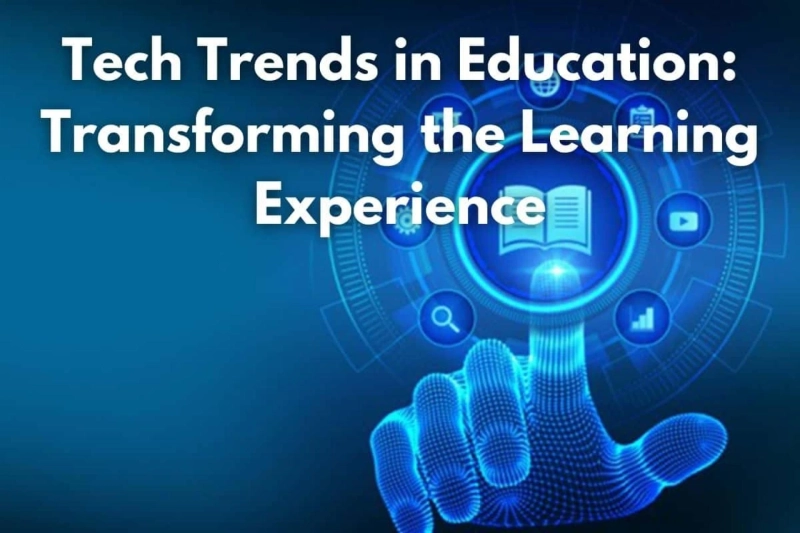Introduction:
In the digital age, technology has become an integral part of every facet of our lives, and education is no exception. The incorporation of technology in education has led to a paradigm shift in the way students learn and educators teach. From interactive learning platforms to virtual classrooms, tech trends in education are revolutionizing the learning experience. In this exploration, we will delve into key tech trends that are reshaping education and transforming how knowledge is imparted and acquired.
1. Online Learning Platforms:
One of the most significant tech trends in education is the rise of online learning platforms. These platforms offer a plethora of courses and resources, allowing students to learn at their own pace and convenience. Massive Open Online Courses (MOOCs) like Coursera, edX, and Khan Academy have democratized education, providing access to high-quality content from top institutions around the world. The flexibility of online learning is particularly beneficial for working professionals and students in remote areas.
2. Virtual and Augmented Reality:
Virtual and augmented reality technologies are making inroads into education, creating immersive learning experiences. Virtual reality (VR) enables students to explore historical landmarks, dissect virtual organisms, or even visit outer space—all from the comfort of the classroom. Augmented reality (AR) overlays digital information onto the real world, enhancing traditional textbooks with interactive 3D models. These technologies bring subjects to life, making complex concepts more tangible and engaging.
3. Adaptive Learning Systems:
Adaptive learning systems use algorithms to personalize the learning experience based on individual student performance. These systems analyze a student\'s strengths and weaknesses, adjusting the curriculum to cater to their unique needs. By providing targeted exercises and real-time feedback, adaptive learning systems help students progress at their own pace, ensuring a deeper understanding of the material. This personalized approach is particularly effective in addressing diverse learning styles within a classroom.
4. Artificial Intelligence in Education:
Artificial Intelligence (AI) is playing a transformative role in education, from automating administrative tasks to providing intelligent tutoring systems. AI algorithms analyze student data to identify patterns, enabling educators to tailor their teaching methods. Chatbots and virtual assistants powered by AI offer instant support to students, answering queries and providing guidance outside regular class hours. AI-driven assessment tools also streamline the grading process, allowing educators to focus on providing meaningful feedback.
5. Gamification of Learning:
Gamification involves incorporating elements of game design into educational activities to make learning more engaging and enjoyable. Educational games and interactive quizzes motivate students to actively participate in their learning journey. Gamified platforms often include rewards, badges, and leaderboard features, fostering a sense of competition and accomplishment. This approach not only captures students\' attention but also promotes a positive learning environment.
6. Cloud-Based Collaboration:
Cloud computing has revolutionized collaboration in education, allowing students and educators to access and share resources seamlessly. Cloud-based platforms like Google Workspace and Microsoft 365 facilitate real-time collaboration on documents, presentations, and projects. This enables students to collaborate on assignments from different locations, fostering teamwork and preparing them for the collaborative nature of the modern workforce.
7. Blockchain for Credential Verification:
Blockchain technology is finding applications in the verification of academic credentials. By storing certificates and diplomas on a blockchain, educational institutions can provide secure and tamper-proof verification of students\' qualifications. This not only reduces the risk of credential fraud but also streamlines the hiring process for employers, ensuring the authenticity of applicants\' educational backgrounds.
8. Robotics and Coding Education:
The integration of robotics and coding education prepares students for the future job market, where digital literacy is increasingly crucial. Robotics kits and coding platforms introduce students to computational thinking and problem-solving skills. Programs like LEGO Mindstorms and initiatives such as coding clubs in schools empower students to create, innovate, and understand the fundamental principles of technology.
Learn More: Tech Trends
Conclusion:
As technology continues to evolve, the role it plays in education becomes increasingly prominent. The tech trends discussed here—online learning platforms, virtual and augmented reality, adaptive learning systems, artificial intelligence, gamification, cloud-based collaboration, blockchain for credential verification, and robotics and coding education—are reshaping the educational landscape. The fusion of these technologies holds the potential to create a more inclusive, personalized, and engaging learning experience for students around the world. As educators and institutions embrace these advancements, the future of education promises to be dynamic, innovative, and better equipped to prepare students for the challenges and opportunities of the digital era.



